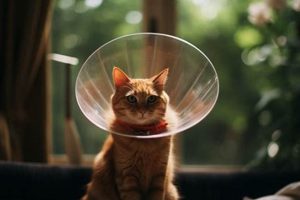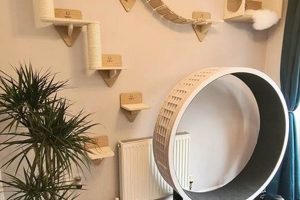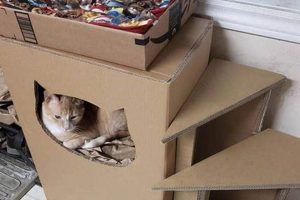A self-constructed housing for a feline’s toilet area represents a creative solution for pet owners seeking to manage litter scatter, odor, and aesthetic integration within their living spaces. This structure, typically built using readily available materials, serves to conceal the litter box while potentially offering features like ventilation, storage, and a more visually appealing design compared to a standard, exposed litter box. Examples range from repurposed furniture like cabinets or end tables, modified to accommodate the litter box, to completely custom-built enclosures utilizing wood, plastic, or other materials.
The practice of concealing a cat’s litter box offers several advantages. Primarily, it addresses concerns about hygiene and cleanliness by reducing the spread of litter and minimizing unpleasant odors. Furthermore, it contributes to a more harmonious living environment by disguising what is inherently an unappealing aspect of pet ownership. Historically, owners have sought creative means to address the functional and aesthetic challenges posed by open litter boxes, leading to a variety of commercially available and homemade solutions designed for concealment and improved hygiene.
The following sections will explore the practical considerations involved in planning and constructing a feline toilet housing, including material selection, design options, construction techniques, and strategies for acclimating the cat to the new environment. This will provide the necessary information for creating a functional and aesthetically pleasing solution.
Construction Strategies for Feline Toilet Housing
The successful creation of a feline toilet housing relies on careful planning and execution. These tips provide essential guidance for a positive outcome.
Tip 1: Material Selection: Prioritize materials that are durable, easy to clean, and resistant to moisture. Untreated wood is susceptible to staining and odor absorption. Consider using sealed wood, plastic, or materials with a waterproof coating for optimal hygiene.
Tip 2: Ventilation Design: Adequate airflow is critical for odor control. Incorporate ventilation holes or a small fan to promote air circulation within the enclosure. Position vents strategically to minimize drafts on the cat.
Tip 3: Accessibility for Cleaning: Design the enclosure with easy access for regular cleaning and litter replacement. A hinged lid, removable panels, or a sliding drawer will simplify maintenance tasks.
Tip 4: Entrance Considerations: The entrance should be appropriately sized for the cat and designed to minimize litter tracking. A slightly elevated entrance or a textured mat near the opening can help contain loose litter.
Tip 5: Stability and Safety: Ensure the enclosure is stable and cannot be easily tipped over by the cat. Avoid sharp edges, protruding nails, or other potential hazards. Secure all components firmly.
Tip 6: Gradual Acclimation: Introduce the cat to the enclosure gradually. Place the litter box inside the open enclosure initially, allowing the cat to become accustomed to the new environment before fully enclosing it.
Tip 7: Size Appropriateness: The interior space should be large enough for the cat to comfortably turn around and maneuver within the enclosure. Insufficient space may deter the cat from using the litter box.
By adhering to these guidelines, individuals can construct a functional and aesthetically pleasing feline toilet housing that effectively addresses the challenges of litter management and enhances the living environment.
The subsequent section will address potential design variations and aesthetic considerations for customized feline toilet housing projects.
1. Concealment
Concealment is a primary motivator for constructing a self-made feline toilet housing. The desire to mask the presence of a litter box stems from aesthetic preferences, space utilization concerns, and the overall goal of creating a more visually appealing living environment. The following facets explore the practical implications of integrating concealment into the process.
- Aesthetic Integration
The visual presence of a standard litter box can detract from the overall decor of a room. Concealment aims to integrate the litter box into the existing design scheme, often by disguising it as a piece of furniture or a decorative element. For example, a litter box housed within a modified cabinet can appear as a side table, blending seamlessly into the room. This allows for functionality without sacrificing visual harmony.
- Odor Mitigation
While not the primary purpose of concealment, an enclosed structure can contribute to odor control by physically containing smells. A well-sealed enclosure, particularly when combined with ventilation, can minimize the spread of odors throughout the room. This function is supplementary to regular litter box cleaning and the use of odor-absorbing litter.
- Space Optimization
Concealment often allows for better utilization of space. A self-constructed enclosure can be designed to serve multiple purposes, such as providing storage space for litter, scoops, and other pet-related items. This dual functionality is particularly beneficial in smaller living spaces where maximizing utility is essential. For instance, a design incorporating shelving above the litter box can provide storage without increasing the footprint.
- Psychological Barrier
The act of concealing the litter box can create a psychological barrier, minimizing the visual reminder of the cat’s waste disposal habits. This can be particularly relevant for individuals who are sensitive to the appearance or smell of the litter box. The concealed unit acts as a subtle buffer, enhancing the overall living experience by removing an unpleasant visual stimulus.
In conclusion, the element of concealment within a self-constructed feline toilet housing serves a multi-faceted role. It primarily addresses aesthetic concerns, contributing to a more visually appealing and harmonious living space, while also providing ancillary benefits such as odor mitigation, space optimization, and a subtle psychological buffer. The specific design and implementation of concealment strategies are dependent on individual preferences, spatial constraints, and desired functionality.
2. Ventilation
Adequate ventilation is a critical aspect of self-constructed feline toilet housings. Enclosing a litter box, while offering aesthetic and hygienic benefits, inherently restricts airflow, potentially leading to concentrated odors and increased humidity. Effective ventilation strategies are thus essential for maintaining a sanitary and comfortable environment for both the cat and the inhabitants of the living space.
- Odor Control
The primary purpose of ventilation within a feline toilet housing is to mitigate the accumulation of unpleasant odors. Decomposing organic matter in the litter box releases volatile compounds responsible for the characteristic smell. Ventilation removes these compounds, preventing them from saturating the enclosure and permeating the surrounding environment. Examples include incorporating screened vents, strategically placed openings, or a low-powered exhaust fan to facilitate air exchange. Without adequate ventilation, even regular litter box cleaning may not fully eliminate odor issues.
- Humidity Reduction
Urine evaporation contributes to elevated humidity levels within the enclosed space. High humidity promotes the growth of bacteria and mold, exacerbating odor problems and potentially creating an unsanitary environment. Ventilation helps to reduce humidity by facilitating the evaporation and removal of moisture-laden air. The implementation of desiccant materials alongside ventilation can further improve humidity control. A poorly ventilated enclosure can become a breeding ground for unwanted microorganisms.
- Cat Comfort and Health
Cats possess a highly sensitive sense of smell. The concentration of odors within a poorly ventilated enclosure can be overwhelming and distressing to the animal, potentially deterring them from using the litter box. Furthermore, prolonged exposure to high humidity and ammonia levels can negatively impact respiratory health. Providing adequate ventilation contributes to the cat’s comfort and well-being, encouraging consistent use of the litter box and minimizing potential health risks. A comfortable environment is vital for positive feline behavior.
- Material Durability
Excessive humidity and ammonia exposure can degrade the materials used in the construction of the enclosure. Untreated wood, in particular, is susceptible to rot and decay in humid environments. Proper ventilation helps to maintain the structural integrity of the enclosure by preventing the buildup of moisture and corrosive substances. Investing in ventilation safeguards the enclosure’s longevity and minimizes the need for frequent repairs or replacements. Durable materials combined with ventilation strategies maximize the lifespan of the structure.
In conclusion, incorporating ventilation into the design and construction of a do-it-yourself feline toilet housing is paramount for managing odors, reducing humidity, promoting the cat’s comfort, and ensuring the longevity of the structure. The specific ventilation method employed should be tailored to the size of the enclosure, the cat’s individual preferences, and the overall environmental conditions of the living space.
3. Accessibility
Within the context of constructing a feline toilet housing, accessibility refers to the ease with which the unit can be cleaned and maintained by the owner, and the ease with which the cat can enter and exit for toileting purposes. Compromised accessibility for either party directly undermines the functional benefits of the enclosure, negating its intended purpose of improving hygiene and aesthetic integration. For example, a meticulously crafted enclosure with a top-entry design might prove unusable if the cat is elderly or has mobility issues, while an enclosure that is difficult to disassemble will discourage regular cleaning, leading to odor build-up and potential health concerns.
The design must therefore balance the desire for concealment and aesthetic appeal with the practical requirements of routine maintenance and feline comfort. A hinged lid, removable panels, or a sliding tray system allows for convenient access to the litter box for scooping and litter replacement. The entrance should be appropriately sized and positioned to accommodate the cat’s physical abilities, avoiding steep inclines or overly small openings that might deter use. A design that prioritizes both owner and feline accessibility ensures the long-term functionality and success of the litter box enclosure.
Ultimately, the accessibility of a self-constructed feline toilet housing is a crucial determinant of its overall value. By carefully considering the needs of both the cat and the owner during the design and construction phases, one can create an enclosure that is not only visually appealing but also practical and easy to maintain, promoting a cleaner, healthier, and more harmonious living environment. Failure to address accessibility concerns can lead to abandonment of the enclosure, negating the time and effort invested in its creation.
4. Materials
The selection of appropriate materials is fundamental to the success of any self-constructed feline toilet housing. Material choice directly impacts the enclosure’s durability, hygiene, aesthetic appeal, and suitability for the feline occupant. Inadequate material selection can lead to structural failures, odor retention, difficulty in cleaning, and potential aversion by the cat, thereby negating the intended benefits of the enclosure. For instance, using untreated plywood in a humid environment will result in warping, mold growth, and unpleasant odors, rendering the enclosure unusable in a short period. Therefore, a comprehensive understanding of material properties and their compatibility with the intended function is paramount.
Practical considerations dictate the use of moisture-resistant, easily cleanable, and non-toxic materials. Sealed wood, plastic, fiberglass, or coated metal are commonly employed. The choice depends on factors such as budget, aesthetic preferences, and construction skills. For example, repurposing an old plastic storage container provides a cost-effective and easily cleaned solution. However, it may lack the aesthetic appeal of a custom-built wooden enclosure. The internal surfaces should be smooth and non-porous to prevent the absorption of urine and odors. Furthermore, any paints, sealants, or adhesives used must be pet-safe to avoid potential health hazards. The physical properties of the materials will also impact the structural integrity and longevity of the enclosure, affecting its ability to withstand daily use and cleaning procedures. Material safety data sheets (MSDS) must be reviewed to ensure the chemical compatibility of chosen materials.
Ultimately, the thoughtful selection of materials is not merely a cosmetic consideration; it is integral to the functionality, longevity, and safety of a self-constructed feline toilet housing. The chosen materials must address the inherent challenges of containing cat waste while integrating harmoniously into the living environment. A failure to prioritize appropriate materials will inevitably lead to a compromised enclosure that fails to meet the needs of both the cat and the owner. This highlights the importance of researching material properties and making informed decisions before commencing construction.
5. Acclimation
Acclimation represents a critical phase in the successful integration of a self-constructed feline toilet housing. A failure to properly acclimate the cat to the new enclosure can result in avoidance of the litter box, leading to unsanitary conditions within the home and potential behavioral issues in the animal. The introduction of a new, enclosed litter box environment inherently alters the cat’s toileting routine, demanding a period of adjustment. This adjustment must be carefully managed to ensure the cat perceives the enclosure as a safe and acceptable place to eliminate. The process involves gradual introduction and positive reinforcement to encourage the cat to use the new facility. For instance, simply placing the familiar litter box inside the new enclosure initially, before any enclosure features are fully assembled, allows the cat to associate positive experiences with the new structure.
The acclimation period can be significantly influenced by factors such as the cat’s age, temperament, and previous experiences with litter boxes. A kitten, for example, may adapt more readily than an older cat who is accustomed to an open litter box. A timid cat might require a more gradual and patient introduction compared to a more confident animal. The type of litter used, the location of the enclosure, and the presence of other animals in the household can also play a role. During the initial stages, placing familiar scents, such as a used blanket or a favorite toy, inside the enclosure can help reduce anxiety and encourage exploration. Positive reinforcement through treats or praise when the cat enters or uses the litter box further reinforces the desired behavior. It’s crucial to avoid forcing the cat into the enclosure, as this can create negative associations and hinder the acclimation process.
In conclusion, acclimation is not a mere afterthought but an integral component of successfully implementing a DIY feline toilet housing. Recognizing the potential stressors associated with a new enclosed environment and implementing a thoughtful, gradual acclimation plan significantly increases the likelihood of the cat accepting and consistently using the new litter box. Patience, observation, and positive reinforcement are key to navigating this process and ensuring a smooth transition for both the cat and the owner, ultimately realizing the intended benefits of the self-constructed enclosure. The integration of familiar elements and positive reinforcement mechanisms is crucial for effective feline acclimation within the DIY litter box context.
Frequently Asked Questions
This section addresses common inquiries regarding the design, construction, and implementation of self-constructed feline toilet housings. The following questions and answers aim to provide clarity and guidance for individuals considering such a project.
Question 1: What are the primary benefits of utilizing a self-constructed feline toilet housing?
The principal advantages include enhanced aesthetic integration, odor control, reduced litter scatter, and the potential for customized design to suit specific spatial and feline needs.
Question 2: Which materials are most suitable for constructing a durable and hygienic feline toilet housing?
Ideal materials exhibit moisture resistance, ease of cleaning, and non-toxicity. Recommended options include sealed wood, plastic, fiberglass, and coated metal. Untreated wood is generally discouraged due to its susceptibility to odor absorption and bacterial growth.
Question 3: How can adequate ventilation be ensured within a self-constructed feline toilet housing?
Ventilation can be achieved through strategically placed screened vents, drilled openings, or the incorporation of a low-powered exhaust fan. The goal is to facilitate air circulation and minimize the accumulation of odors and humidity.
Question 4: What design considerations are essential for optimizing accessibility for both the cat and the owner?
The entrance should be appropriately sized and positioned for the cat’s comfort. The enclosure should incorporate features such as hinged lids, removable panels, or sliding trays to facilitate easy cleaning and litter replacement.
Question 5: How can the risk of the cat rejecting the new enclosure be minimized?
A gradual acclimation process is crucial. Start by placing the familiar litter box inside the open enclosure before fully enclosing it. Introduce familiar scents and use positive reinforcement to encourage exploration and use. Avoid forcing the cat into the enclosure.
Question 6: Are there specific safety concerns to consider when constructing a feline toilet housing?
Ensure the enclosure is stable and cannot be easily tipped over. Avoid sharp edges, protruding nails, or other potential hazards. Use only pet-safe paints, sealants, and adhesives to prevent potential health risks.
Effective implementation of a self-constructed feline toilet housing hinges on careful planning, appropriate material selection, and attention to the cat’s needs. By addressing these considerations, a functional and aesthetically pleasing solution can be achieved.
The next section will provide some creative design ideas to make your design unique.
Conclusion
The preceding analysis has elucidated critical aspects of the diy cat litter box enclosure, ranging from material selection and ventilation strategies to feline acclimation techniques. The advantages of constructing customized housings, including aesthetic integration, odor mitigation, and space optimization, have been thoroughly examined. Furthermore, potential challenges and safety considerations have been addressed to ensure a practical and responsible approach.
Successful implementation of a diy cat litter box enclosure relies on a synthesis of practical knowledge, creative design, and a deep understanding of feline behavior. It demands meticulous planning, thoughtful execution, and a commitment to creating a sanitary, functional, and aesthetically pleasing environment for both the cat and the owner. The pursuit of this endeavor represents not only an exercise in craftsmanship but also a commitment to responsible pet ownership and harmonious cohabitation.







